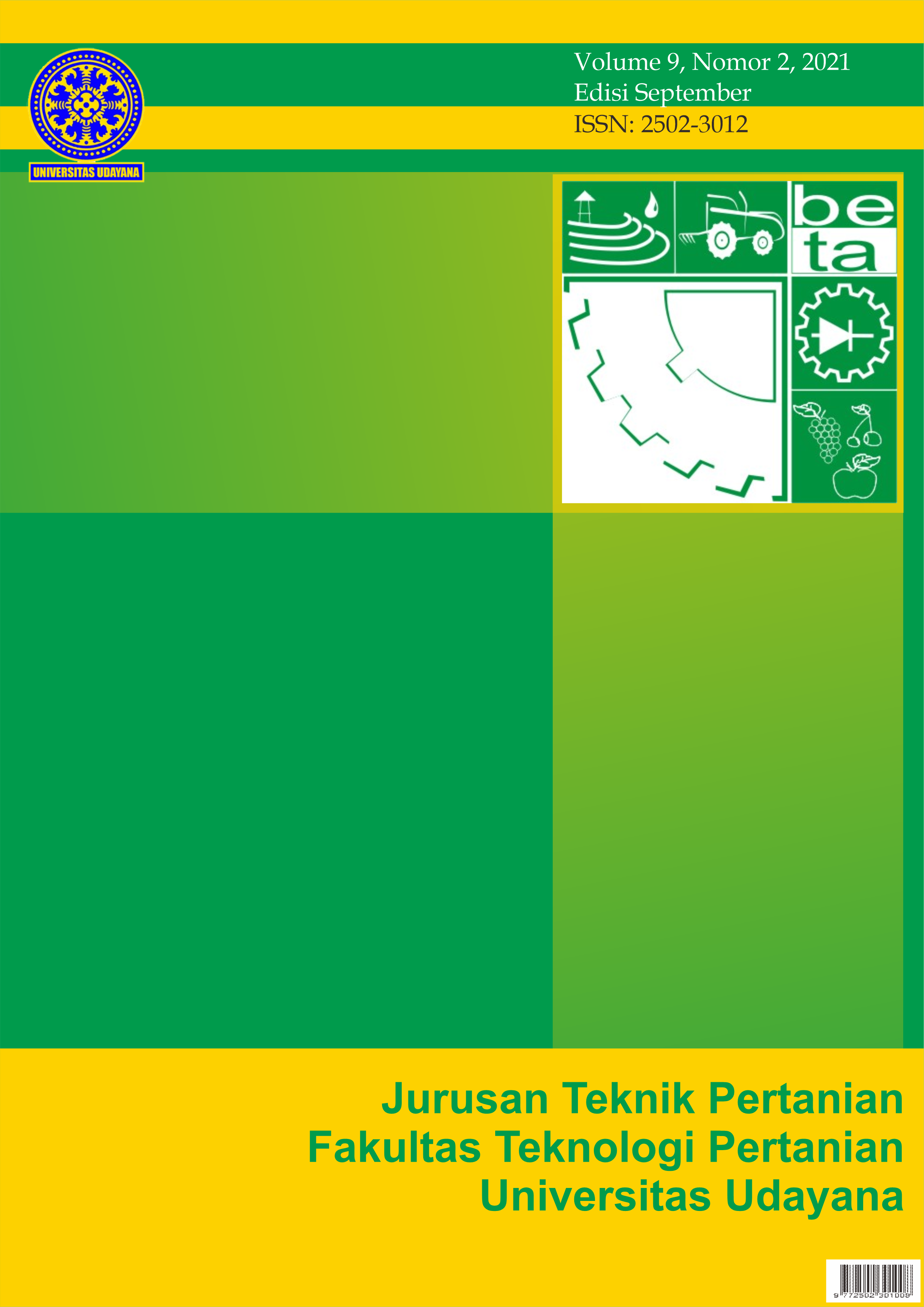Pengaruh Penggunaan Beberapa Jenis Mulsa terhadap Sifat Fisik Tanah dan Laju Pertumbuhan Tanaman Tomat (Lycopersicum Esculentum L)
Abstract
ABSTRAK
Pengolahan tanah secara intensif tanpa memperhatikan faktor-faktor yang mempengaruhinya antara lain kurangnya unsur hara, pemupukan yang tidak berimbang dapat menurunkan kualitas sifat fisik tanah. Oleh karena itu dibutuhkan pengolahan tanah agar sesuai dengan syarat tumbuh tanaman tomat. Penggunaan berbagai jenis mulsa pada tanaman tomat diharapkan mampu menciptakan iklim mikro yang sesuai bagi tanaman, memperbaiki sifat fisik tanah antara lain bahan organik tanah, permeabilitas, porositas tanah dan laju pertumbuhan, melancarkan pendauran hara dalam sistem tanah, air, tanaman dan memperbaiki ketersediaan hara bagi tanaman. Tujuan penelitian ini adalah untuk mengetahui perubahan sifat fisik tanah akibat penggunaan jenis mulsa sejalan dengan usia tanaman tomat dan mengetahui pengaruh penggunaan jenis mulsa terhadap laju pertumbuhan tanaman tomat. Penelitian ini dilakukan dengan rancangan acak lengkap dengan perlakuan tanpa mulsa, mulsa plastik perak, mulsa plastik hitam, mulsa plastik UV transparan, dan mulsa jerami padi. Setiap perlakuan diulang sebanyak tiga kali sehingga terdapat 15 plot. Hasil penelitian menunjukkan bahwa kadar air tanah 2 MST 13-35%, 4MST 20-42%, 6MST 23-44%, 8MST 27-51%, 10MST 26-53%, 12MST 32-63%. Rata-rata bahan organik tanah 1,16% dengan kategori rendah. Rata-rata permeabilitas tanah 4,13 cm/jam dengan kategori lambat sampai sedang. Perlakuan tanpa mulsa berpengaruh nyata pada porositas tanah dengan nilai rata-rata 48% pada kelas kurang baik. Rata-rata nilai jumlah daun pada perlakuan mulsa plastik perak 122.89 helai dan pada perlakuan jerami padi 124.83 helai. Nilai berat kering tanaman tomat pada perlakuan mulsa jerami padi 205.87 gram dan pada perlakuan mulsa plastik UV transparan 118.33 gram.
ABSTRACT
Soil processing intensively without paying attention to factors that affect it such as the lack of nutrients, unbalance fertilization decreases the physical quality of the soil. Therefore, soil processing is necessary to the growing condition of the tomato plants. The use of various types of mulch on tomato plants is expected to create a microclimate that suitable for plants, improve soil physical properties including soil organic matter, permeability, soil porosity, and growth rate, reinforce nutrient cycling in the soil, water, plant system and improve nutrient availability for plants. The aims of the research are to determine the changes in soil physical properties due to the use of mulch types in line with the age of tomato plants and determine the effect of the use of mulch types on the rate of growth of tomato plants. This research is conducted with a completely randomized design with treatment without mulch, silver plastic mulch, black plastic mulch, transparent UV plastic mulch, and rice straw mulch. Each handling 15 times. The results show that the groundwater content of 2 MST was 13-35%, 4MST 20-42%, 6MST 23-44%, 8MST 27-51%, 10MST 26-53%, 12MST 32-63%. Average soil organic matter 1.16% with low category. The average permeability of land is 4.13 cm/hour in the slow to moderate category. Treatment without mulch significantly affected the soil porosity with an average value of 48% in the less grade. The average value of the number of leaves in the silver plastic mulch treatment 122.89 strands and 124.83 strands of rice straw. The dry weight value of tomato plants in the treatment of rice straw mulch 205.87 grams and in the treatment of transparent UV plastic mulch 118.33 grams.
Downloads
References
Arga 2010 Pengantar Ilmu Pengendalian gulma Ilmu Gulma Buku I Rajawali Press Jakarta p.122
Ashari, S. 2006. Hortikultura Aspek Budidaya. Universitas Indonesia, Jakarta.
Brady, N. C dan Ray R. Weil. 2008. The Nature and Properties Of Soil. Pearson Prentice Hall, Ohio
Endriani. 2010. Sifat Fisika dan Kadar Air Tanah Akibat Penerapan Olah Tanah Konservasi. Jurnal Hodrolitan. Vol. 1, No.1 : 26 – 34.
Fried, George H. dan George J. Hademenos. 2006. Schaum’s Outlines: Biologi Edisi Kedua. Jakarta: Erlangga.
Hanafiah, Kemas Ali. 2005. Dasar-Dasar Ilmu Tanah. Jakarta: Raja Grafindo.
Hardjowigeno, S. 2010. Ilmu Tanah. Akademika Pressindo. Jakarta. 288 hal.
Lumbanraja, P. 2013. Pengaruh Pola Pengolahan Tanah dan Pupukkandang terhadap Beberapa Sifat Fisika Tanah dan Pertumbuhan Vegetativ Tanaman Kacang Tanah (Arachis hypogea L) pada Ultisol Simalingkar.
Prosiding Seminar Nasional BKS-PTN Wilayah Barat Indonesia, (Hal.: 599 s/d 607). Pontianak. Kalimantan Barat. 19-20 Maret 2013.ISBN 978-602-17664-1-5.
Pitojo, Setijo. 2005. Bertanam Tomat. Kanisius. Yogyakarta.
Purwati, E. dan Khairunisa. 2007. Budidaya Tomat Dataran Rendah dengan Varietas Unggul serta Tahan Hama dan Penyakit. Penebar Swadaya. Jakarta. 67 hlm.
Puslittanak. 2005. Satu Abad : Kiprah Lembaga Penelitian Tanah Indonesia 1905 – 2005. Pusat Penelitian dan Pengembangan Tanah dan Agroklimat, Bogor. Sutandi, C.M. 2012. Air Tanah. Fakultas Teknik. Univesitas Kristen Maranatha. Bandung
Sutanto, R., 2005. Dasar-dasar Ilmu Tanah Konsep dan Kenyataan. Kanisius, Yogyakarta
Tim Bina Karya Tani. 2009. Pedoman Bertanam Tomat. Bandung: Yrama Widya.
Trisnoto, 2008. Tingkat Erodibilitas Tanahdi Kecamatan Ambarawa Kabupaten Semarang Provinsi Jawa Tengah. Fakultas Geografi : Universitas Muhammadiyah Surakarta.
Tugiyono, H. 2005. Bertanam Tomat. Penebar Swadaya. Jakarta.
Umboh, A. H. 2000. Petunjuk Penggunaan Mulsa. Penebar swadaya, Jakarta
Wiryanta, W. 2002. Bertanam tomat. Agromedia Pustaka. Jakarta: 102 halaman.












 Jurnal BETA (Biosistem dan Teknik Pertanian)
Jurnal BETA (Biosistem dan Teknik Pertanian)


